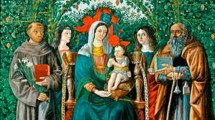Abstract
Medicinal plants and their compounds (such as essential oils) have been presented in the fine arts of many periods of civilization. They have been from former times up to now not only subjects of lyric poetry and prose, but also of pictorial art. In paintings medicinal plants — just as many other plants — were not used only because of their decorative characters, but also for their symbolical significance. This symbolism can be demonstrated by many examples. It is especially true as far as the symbolical character of certain medicinal plants within Dutch painting is concerned.
May I, as an amateur in the history of art, be allowed to extend the conception of Dutch painting in a certain European sense, for it was the Dutch painters who — in spite of typical Dutch subject and details in their paintings — have never been restricted to the region of the historical Netherlands.
The red thread of this lecture will be similar to a meander. I will take your ears and eyes and lead you through my artificial garden with blooming plants and ripe fruits. During this walk you will meet for example Jan Breughel’s famous picture ‘Flower bunch in a wooden pot’, to-day in the Alte Pinakothek of Munich. There is Frittiiaria imperialis in the center of the bouquet, surrounded by Lilium candidum, Lilium martagon, Iris species, and Lilium hulbiferum and roses, all old symbols, already mentioned in the middle-ages and referring to the virginity and innocence of St. Mary. I will take you to the Portinari altar-piece, painted by Hugo van der Goes in Florence, With Iris, Di an thus, Aquilegia and Lilium hulbiferum in front of the crib. I will try to explain the symbolism of the pomegranate used already in art by Old Egyptians, but also by Abraham Breughel in 1669 or by the modern artist E. schlotter in his picture ‘Nocturno’, which dates from 1977. This fruit full of seeds, with its sweet and sour taste symbolizes not only life, fertility and productivity, eros and voluptuousness, but also charity and the wisdom of old age. With these and other examples I will demonstrate to you both the beauty of Dutch painting and the plant symbolism implied, which had such a long history from ancient periods until to-day.
Meiner Mutter in Dankbarkeit gewidmet
Access this chapter
Tax calculation will be finalised at checkout
Purchases are for personal use only
Preview
Unable to display preview. Download preview PDF.
Similar content being viewed by others
Literatur
Behling L. 1967, Die pflanzen in der mittelalterlichen Tafelmalerei, Köln/Graz, Böhlau-Verlag.
Czygan F-C. 1981, Ätherische Öle und Duft — kulturhistorisch betrachtet, Pharmazie in unserer Zeit 10:109–121;
Czygan F-C. 1984, 4000 Jahre Ätherische Öle — eine kunst- und kulturhistorische Exkursion, Ärztez. f. Naturheilverf. 25:500.
Behling L. 1964, Die Pflanzenwelt der mittelalterlichen Kathedralen, Köln/Graz, Böhlau-Verlag.
Czygan F-C. 1983, Ätherische Öle, Duft und Literatur: ein naturwissenschaftlich-poetischer Dreiklang, Kneipp-Physiotherapie 3:2–5.
Lehner E, Lehner J. 1960, Folklore and symbolism of flowers, plants and trees, New York,
Schmidt H, Schmidt M. 1982, Die vergessene Bildersprache christlicher Kunst, München, CH Beck.
Sachs H, Badstübner E, Neumann H. o.J., Erklärendes Wörterbuch zur christlichen Kunst, Hanau, W Dausien-Verlag.
Leyser H (Herausg.). 1838, Deutsche Predigten des 13. und 14. Jahrhunderts, Quedlinburg/Leipzig.
Würzburg K von. 1966, Die goldene Schmiede (‘Altdeutsche Wälder’ hrsg. von den Brüdern Grimm, Frankfurt, 1815), Reprint Darmstadt.
Sachs H, Badstübner E, Neumann H. o.J., Erklärendes Wörterbuch zur christlichen Kunst, Hanau, W Dausien-Verlag., Seite 285.
Kauffmann H. 1943, Die Fünfsinne in der niederländischen Malerei des 17. Jahrhunderts, in: Kunstgeschichtliche Studien. Festschrift für Dagobert Frey (Tintelnot H, Hrsg.), Breslau.
Winkelmann-Rhein G. 1979, Blumen-Breughel, Köln, DuMont Buchverlag. zu J. Breughel d.Ä. vgl. auch
Baumgart F. 1978, Blumen-Breughel, Köln, DuMont Buchverlag.
Segal S. 1983, Niederländische Stilleben, Katalog zur Ausstellung, Braunschweig, Herzog Anton Ulrich-Museum.
Fritz R. 1952, Aquilegia, die symbolische Bedeutung der Akelei, Wallraf-Richartz-Jahrbuch, Köln
(7ab)Löber K. 1977, Pflanzensymbolik der mittelalterlichen Tafelmalerei mit besonderer Berücksichtigung der Akelei, Symbolon N.F. Heft 3.
Noli-me-tangere-Altar: ca. 1425, Meister des Göttinger Barfüsser-Altars; Staatsgalerie, Stuttgart.
Maria im Rosenhag: 1473, Martin Schongauer (1450–1491); Münster St. Martin, Colmar, Frankreich.
Maria im Rosenhag: um 1448, Stephan Lochner (1400/15–1451/52); Wallraf-Richartz-Museum, Köln.
Portinari-Aitar: um 1473–1475, Hugo van der Goes (1440/45–1482); Uffizien, Florenz.
Allegorie der Fünf Sinne (hier: Der Geruch): 1617–1618, Jan Breughel d.Ä, (1568–1625); Prado, Madrid.
Blumengarbe in einem Holzkübel: um 1610?, Jan Breughel d.Ä.; Alte Pinakothek, München.
Madonna im Blumenkranz: 1618–1620, Peter Paul Rubens (1577–1640) und Jan Breughel d.Ä.; Alte Pinakothek, München.
Pfirsich-Stilleben mit der Maus: 1674, Willem van Aelst (ca. 1625-ca. 1683); Privatsammlung.
Maria mit dem Granatapfel: Filippino Lippi (1457?-1504); Louvre, Paris.
Stuppacher Madonna: 1519, Matthias Grünewald — eigentlich: Mathis Gothart Nithart — (ca. 1480–1528); Stuppacher Kirche bei Bad Mergentheim, BRD.
Kartusche mit Blumen und Früchten: Pieter de Ring (1615–1660); Gallerie Müllenmeister, Solingen, BRD.
Frau, die nach Früchten greift (Ausschnitt: Granatäpfel): 1669, Abraham Breughel (1631–1697); Louvre, Paris.
Stilleben mit Blumen und Früchten: Jan van Huysum (1682–1749); Rijks-museum, Amsterdam.
Nocturno: 1977, Eberhard Schlotter (1921-); Privatbesitz.
Editor information
Editors and Affiliations
Rights and permissions
Copyright information
© 1985 Martinus Nijhoff/Dr W. Junk Publishers, Dordrecht, The Netherlands
About this chapter
Cite this chapter
Czygan, FC. (1985). Arzneipflanzen im Spiegel Niederländischer Malerei. In: Svendsen, A.B., Scheffer, J.J.C. (eds) Essential Oils and Aromatic Plants. Springer, Dordrecht. https://doi.org/10.1007/978-94-009-5137-2_27
Download citation
DOI: https://doi.org/10.1007/978-94-009-5137-2_27
Publisher Name: Springer, Dordrecht
Print ISBN: 978-94-010-8772-8
Online ISBN: 978-94-009-5137-2
eBook Packages: Springer Book Archive




